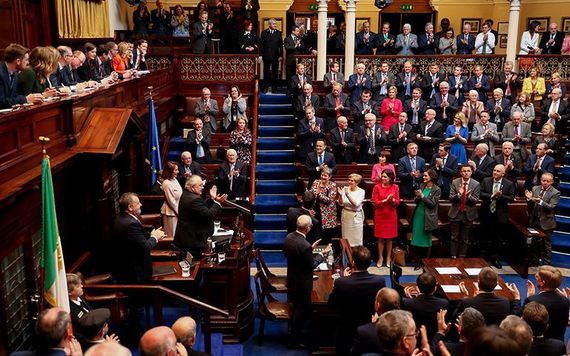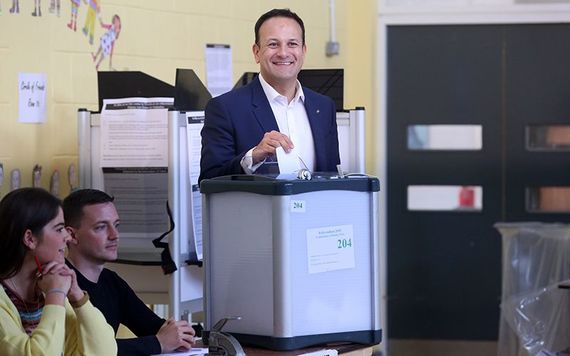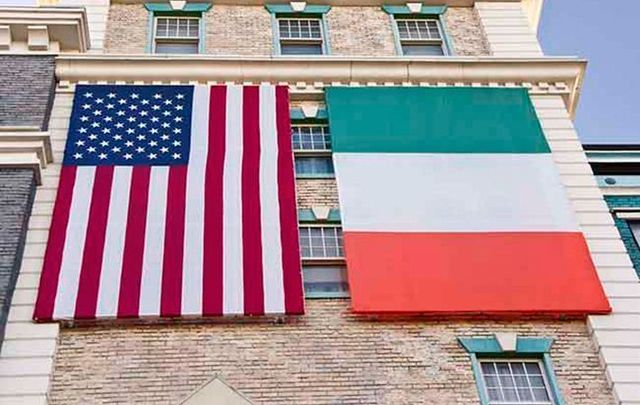The 2020 general election kicked off in Ireland yesterday.
Leo Varadkar, the current Taoiseach (Prime Minister) dissolved the Dáil (Ireland’s parliament) with the permission of President Michael D. Higgins, giving Ireland’s political parties three weeks to campaign before the country’s leadership is decided in an election to be held on February 8.
Meanwhile, here in the US, we’re nine months away from Election Day and it’s close to one year since the election cycle began in earnest after the candidates officially threw their names in the ring between March and July of last year.
As candidates continue to drop out and the field is whittled down, we're still far from knowing who the nominees even will be.
Ireland and the US are obviously very different political playing fields. Ireland is a parliamentary democracy with a population of 4.6 million; the US is a representative democracy with a population of 318.9 million and also, depending upon who you talk to, the leader of the free world.
But the stark differences between how elections play out in Ireland and the US cannot be neatly chalked off to population size and type of democracy.
When you look at the differences in voter turnout, election spending, and campaign duration, it becomes clear that the US could actually learn a thing or two from Ireland.
Read more: Irish general election called for February 8
Here’s a list of the top ways in which the Irish election process is far more efficient:
1. Campaign spending

Image: Getty.
In 2011, campaign spending for Ireland’s general elections totaled $10.6 million (€9.2 million). In 2016, spending was also expected to exceed $11.1 million (€10 million) – a record.
In the US, campaign spending for the 2016 elections was also expected to reach a record high: $10 billion. Out of this, $4.4 billion would be spent on TV ads alone.
In Ireland, paid political ads are not allowed. In the three weeks leading up to the election, all of the political parties are granted broadcast slots.
As for donations, in Ireland, no candidate can receive an individual donation greater than €2,539.48 for election expenses, and no political party can receive an individual donation greater than €6,348.69 for election expenses, according to Citizens Information.
As Albert R. Hunt wrote in a column for Bloomberg Views on the projected record-breaking election spending in the US for 2016, “All of the top contenders have sugar daddies, billionaires who seem willing to spend unprecedented sums on their campaigns, principally via the super-PACs, which have no contribution limits; these entities are supposed to be independent of the campaign, a fiction that no one believes.”
While it could and has been argued that America’s size accounts for its exorbitant campaign spending (the US spends more on elections than any other country), this doesn’t hold weight when you look at the spending in other democracies of similar sizes. As a 2014 article from the Sunlight Foundation noted, India, which has a population of 1.3 billion (much larger than America’s 318.9 million) spent $5 billion during its last general election. Brazil, which has a population of 200 million, spent $2 billion on its last election cycle.
2. The Dáil (Ireland’s House of Representatives) is dissolved for the duration of the election cycle

Nancy Pelosi in the Dáil. Image: RollingNews.ie.
How could anyone seriously be considered to be attending to their duties in the political office while devoting their time to the campaign trail? In the US it’s completely acceptable that presidential candidates (here’s looking at you, Senators Elizabeth Warren and Bernie Sanders) can serve in their current roles as members of congress, the senate or as governors, while on the road campaigning for months upon months.
In the November 2015 Republican debate, Marco Rubio came under fire for being away from Capitol Hill and missing a large number of Senate votes – 18 out of 20 in the month of October.
However, as some number-crunching by Vox confirmed, this is not at all unusual. In the year leading up to the 2008 presidential election, Joe Biden, Hillary Clinton, John McCain and Barack Obama, all of whom were in office at the time, missed 80%, 83.5%, 76.5%, and 89.4% respectively of the Senate votes they should have been present for.
In Ireland, the Dáil (Parliament) is dissolved for the duration of campaigning. Could you imagine the House of Representatives taking a year and a half recess? Nothing would get done … oh, wait.
3. Oversaturation and voter fatigue
After the race, what happens to all the campaign signs? https://t.co/vgCrVFObpw pic.twitter.com/93cUdKrKm6
— The Boston Globe (@BostonGlobe) February 5, 2016
There’s a lot to be said for an election cycle that lasts only three weeks. In the year before the US elections – particularly before the caucuses, the primaries and the big day itself – campaign signs dot the landscape across the country, and campaign ads play incessantly on TV, radio and online.
As two Iowans who spoke to the New York Times before the 2016 caucus cataloged, “Drove to pick up daughter and run errands: 16 yard signs, 9 large vinyl signs on privacy fences, 4 billboards. Saw 17 cars with current stickers (this will pick up AFTER the caucus when it’s down to two or three real candidates). Listened to a CD to avoid radio ads.”
And “Television ads on CBS. 6:09 p.m. pro-Marco Rubio. 6:11 pro-Ted Cruz. 6:15 anti-Marco Rubio. 6:20 pro-Marco Rubio. 6:20 anti-Marco Rubio. 6:21 pro-Bernie Sanders. 6:25 anti-Ted Cruz. 6:27 pro-Ted Cruz. 6:29 Donald Trump bashing Ted Cruz. 6:37 pro-Jeb Bush. 6:42 anti-Marco Rubio. 6:48 pro-Hillary Clinton.”
Ireland has exceedingly strict rules about campaign ads and materials. Any signs put up before the election cycle begins will be removed, and even any posters erected during the election cycle require the permission. Posters left up for longer than the election will subject their parties to a fine.
According to CitizensInformation.ie, “The law in Ireland forbids the erection of posters/signs on poles or other structures in public places unless you have the written permission of the owner of the pole or other structure in advance of putting up the posters/signs. Posters are only allowed to be erected for a certain specified time period before an election. Posters can be erected 30 days before the election or from the date of the polling day order for the election, whichever is the shorter period of time.
“Following a general election, a party/candidate must remove posters within a seven day period. After that date, an on-the-spot fine of €150 is issued by your local authority in respect of each offence. Your local authority will remove the poster as the fine is issued.”
4. Voter turnout

Taoiseach Leo Varadkar casting a vote. Image: RollingNews.ie.
The US may have a longer, more expensive election cycle than most other democracies, but unfortunately, that doesn’t result in higher voter turnout.
As the Pew Research Center noted in a study published in May 2015, voter turnout in the US trails that of most other developed countries.
Only slightly more than half - 53.6% - of the United States’ voting-age population voted in the 2012 elections. On a list of the 34 countries in the Organization for Economic Cooperation and Development, the US ranked 31st among the 34 countries. Ireland ranked 19th, with a voter turnout of 63.8%.
A 2013 study comparing the election systems of Ireland and the US by Fair Vote, a non-partisan non-profit, also speculated that the way voting works in Ireland (proportional representation or “choice voting”), as opposed to the US, also impacts voter perception.
“If you ask Americans what it means to ‘vote,’ they might say ‘look at the list of candidates and pick the one you want.,” they wrote, “But in Ireland, people see voting differently. The Irish vote by looking at a list of candidates and ranking them in order of preference” which results in a representative who more accurately reflects the preferences of the voting population."
In your opinion, which country has a better election system, Ireland or the US? How would you like to see either system change? Share your thoughts in the comment section, below.
*Originally published in February 2016.




Comments